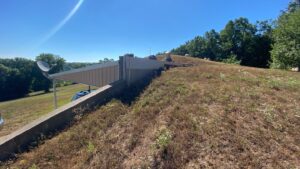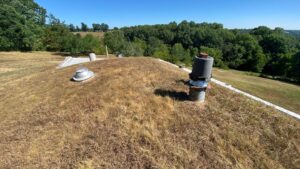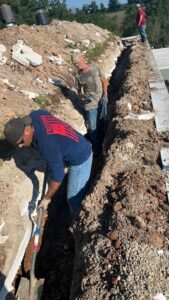I’ve been talking for weeks about getting a new roof on my house. This was no small undertaking, considering our house is earth-sheltered with an earth roof over a concrete structure. We had been trying for about three years to find someone to redo the original earth covering and waterproofing. No one in this area (Southwest Missouri) knew how to do it. The nearest companies that build earth-sheltered homes were in Kansas City and Tulsa, and those companies weren’t willing to travel to our rural area just to replace the roof.
We house was built in 1999 by a company in Minnesota. The roof was only warranted for ten years, and it lasted maybe 15, but after that we started having major leaks resulting in significant damage to the stucco exterior and some interior walls where water trickled down through the concrete structure.
Since we couldn’t find anyone to fix the earthen material, we decided our only option was to build a roof over it. However, we wanted to maintain as much of the earth as possible, since that’s our insulation. It was worth hanging on to. In the winter, if we turn the central heat off, even in the coldest weather the house doesn’t get below about 62 degrees. We do have to air condition in the summer because of humidity.
We started looking for contractors to build a roof structure tied in to the existing concrete structure of the house. A couple of estimators told us they were interested in the project, only to disappear once they thought it over and figured out what they were getting into. After three years of waiting for contractors who simply didn’t show up or quit communicating with us, we were at our wits end.
I finally started calling contractors again, most of whom must have heard about us, because most wouldn’t even come for an estimate. But Nathaniel Cotten Construction of Neosho did. Nathaniel looked the house over and said he’d call in a few days with a bid. We’d heard that before.
 But a few days later, there it was, and much less than the highest bid we’d gotten from a company that ghosted us. Even better, he had a crew ready to start in three weeks. To the left is another view of what the original roof looked like from the back of our house.
But a few days later, there it was, and much less than the highest bid we’d gotten from a company that ghosted us. Even better, he had a crew ready to start in three weeks. To the left is another view of what the original roof looked like from the back of our house.
And one from the front, where you can see that one side is two stories.
After spending some time studying the original house plans, he and my husband Carl figured out—sort of—where the walls were so they could start digging. We thought there was about three feet of dirt on top of the walls. Turns out, there was closer to six, so there was a lot of digging.

Most of the digging had to be done by hand by the poor guys with shovels in order to preserve as much of the earth on the roof as possible. Nathaniel also made sure they were careful not to damage the waterproofing on the back wall.
Stay tuned. I’ll have more information next week!
